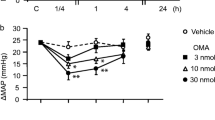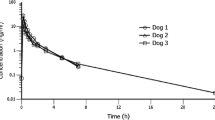Summary
This study investigated the effects of the intracarotid infusion of etoposide in combination with angiotensin 11 (AT 11)-induced hypertension on the blood-brain barrier (BBB) and brain tissue in rats. Eighty rats were divided into five groups: Group 1, intravenous infusion of AT 11 to increase arterial blood pressure; Group 2, intracarotid infusion of etoposide at 22.5 mg/m2 for 10 minutes; Group 3, intracarotid infusion of etoposide at 75.0 mg/m2 for 10 minutes; Group 4, intracarotid infusion of etoposide at 75.0 mg/m2 for 20 minutes; Group 5, intracarotid infusion of etoposide at 75.0 mg/m2 for 10 minutes with AT 11-induced hypertension. Evans blue staining of the brain was used as a monitor of BBB disruption. Mean arterial blood pressure over the experimental period in Group 1 increased from 86.3 ± 1.3 mmHg (mean ± SEM) to 139.0 ± 2.4 mmHg, and Group 5 from 85.9 ± 1.8 mmHg to 137.3 ± 2.4 mmHg. None of the animals in Group 1 and 2 showed any obvious neurological change, while all the animals in Group 3, 4 and 5 exhibited diminished activity as their sole neurological change throughout the course of the experiment. Slight evidence of BBB disruption was seen in only 25% of the animals in Group 1. Significant BBB disruption was found in the animals in Group 2, 3, 4 and 5. No histological change was observed in any animal in Group 1 and 2. Demyelination, cerebral edema, and neuronal change on the infused hemisphere were observed in half of the animals in Group 3, 4 and 5, but no marked difference was observed among the three groups.
At II-induced hypertension is unlikely to have an adverse effect by itself on the BBB and brain tissue. However, intracarotid infusion of high-dose etoposide is capable of producing BBB disruption and irreversible neuronal damage by itself irrespective of infusion rate. Modification of BBB and neuropathological change in case of intracarotid infusion of etoposide with AT 11-induced hypertension primarily caused by etoposide itself and not by the AT II-induced hypertension.
Similar content being viewed by others
References
Levin VA, Kabra PM, Freeman-Dove MA: Pharmacokinetics of intracarotid artery 14C-BCNU in the squirrel monkey. J Neurosurg 48: 587–593, 1978
Neuwelt EA, Glasberg M, Frenkel E, Barnett P: Neurotoxicity of chemotherapeutic agents after blood-brain barrier modification: Neuropathological studies. Ann Neurol 14: 316–324,1983
Nagahiro S, Yamamoto YL, Diksic M, Mitsuda S, Sugimoto S, Feindel W: Neurotoxicity after intracarotid 1,3-bis(2chloroethyl)-1-nitrosourea administration in the rat: Hemodynamic changes studied by double-tracer autoradiography. Neurosurgery 29: 19–26, 1991
Spigelman MK, Zappulla RA, Strauchen JA, Feuer EJ, Johnson J, Goldsmith SJ, Malis LI, Holland JF: Etoposide induced blood-brain barrier disruption in rats: Duration of opening and histological sequelae. Cancer Res 46: 1453–1457, 1986
Leff RS, Thompson JM, Daly MB, Johnson DB, Harden EA, Mercier RJ, Messerschmidt GL: Acute neurologic dysfunction after high-dose etoposide therapy for malignant glioma. Cancer 62: 32–35, 1988
Suzuki M, Hori K, Abe I, Saito S, Sato H: A new approach to cancer chemotherapy: Selective enhancement of tumor blood flow with angiotensin II. JNCI 67: 663–669, 1981
Mitsuhata N, Seki M, Hino N, Shimohara Y, Suga K, Nishigaki S, Tanigawa M, Manabe T, Asano T: Intra-arterial cis-diamminedichloroplatinum and angiotensin II infusion chemotherapy in patients with metastatic brain tumor or advanced bladder cancer. Proc of 14th international congress of chemotherapy. Anticancer Section 1: 395–396, 1985
Ogasawara H, Uozumi T, Kiya K, Kurisu K, Mikami T, Hotta T, Sugiyama K: Etoposide delivery to malignant brain tumors with induced hypertension by angiotensin II. International Symposium on Advances in Neuro-Oncology (Abstract): 140, 1990
Pappius HM, Savak HE, Fieschi C, Rapoport SL Sokoloff L: Osmotic opening of the blood-brain barrier and local cerebral glucose utilization. Ann Neurol 5: 211–219, 1979
Johanson BB, Standgaard S, Lassen NA: On the pathogenesis of hypertensive ‘break through’ of autoregulation of cerebral blood flow with forced vasodilation, flow increased and blood-brain barrier damage. Circ Res 34 Suppl 1: 161–171, 1974
Baumbach GL, Heistad DD: Heterogeneity of brain blood flow and permeability during acute hypertension. Am J Physiol 249: 629–637, 1985
Bradbury M: The concept of a blood-brain barrier. John Wiley & Sons, Chichester 351–382, 1979
Vriesendorp FJ, Pasternak JF, Groothuis DR: The effect of systemic hypertension on blood-to-tissue transport in experimental gliomas. J Neuro-Oncology 5: 289–297, 1987
Rapoport SI: Experimental modification of blood-brain barrier permeability by hypertonic solutions, convulsions, hypercapnia and acute hypertension. In: Cserr HF, Fenstermacher JD, Fencl V (eds) Fluid Environment of the Brain. Academic Press, New York 61–80, 1975
Allen LM: Comparison of uptake and binding of two epidophyllotoxin glucopyranoside 4′-demethylepipodophyllo-toxin ethylidene B-D-glucoside in the L1210 leukemia cell. Cancer Res 38: 2549–2554, 1978
Hollis PH, Zappula RA, Spigelman MK, Feuer EJ, Holland JF, Malis LI: Effect of etoposide-induced blood-brain barrier disruption on brain water, intracranial pressure, and cerebral vasomotor tone. Experimental Neurology 99: 428–439, 1988
Savaraj N, Lu K, Fenn LG, Burgess MA, Loo TL: Comparison of CNS penetration, tissue distribution, and pharmacology of VP 16–213 by intracarotid and intravenous administration in dogs. Cancer Investigation 5: 11–16, 1987
Lee JC: Effect of alcohol injections on the blood-brain barrier. Q J Stud Alcohol 23: 4–16, 1962
Spigelman MK, Zappulla RA, Johnson J, Goldsmith SJ, Malis LI, Holland JF: Etoposide-induced blood-brain barrier disruption. J Neurosurg 61: 674–678, 1984
Author information
Authors and Affiliations
Rights and permissions
About this article
Cite this article
Ogasawara, H., Kiya, K., Kurisu, K. et al. Effect of intracarotid infusion of etoposide with angiotensin II-induced hypertension on the blood-brain barrier and the brain tissue. J Neuro-Oncol 13, 111–117 (1992). https://doi.org/10.1007/BF00172760
Issue Date:
DOI: https://doi.org/10.1007/BF00172760




